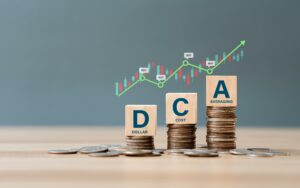What is short trading?

Short and Long trading are two principal terms traders get to know while learning and applying their trades. When a trader enters a long position, it means they purchase an instrument and wait for its price to rise before selling it. But what happens when you expect an instrument’s price to decline? In this scenario, you can use shorting, or short trading, which means you borrow the instrument and sell it, with the intention of buying it again in the future at a lower price.
Although short selling can sound a little confusing and very different from the traditional definition of stock trading, it is an effective tool to identify more trading opportunities in a volatile market, and the way of trading in a declining market.
Klips explains: What is short selling?
Short selling is a trading strategy where you sell an instrument with the plan of buying it later at a lower price. Essentially, you are predicting a decline in the price of the instrument, which will allow you to buy the instrument at a lower price in the future while profiting from the difference. This kind of strategy is followed in a bearish market.
The position is opened by borrowing the instrument from the broker. This means you must open a margin trading account for stocks, currencies, or any other instrument you wish to short. The margin here is the security deposit you provide to the broker, which acts like collateral for the borrowed instruments.
For example, Company A’s shares are currently trading at $200 a share, and you believe they are overpriced. You expect the price to decline and take a short position by borrowing 10 shares from your broker and selling these shares for $2,000. If the stock price declines to a price of $100, you buy 10 shares from the market by paying $1,000 and return them to the broker. This means you buy the shares for $100 and sell them for $200, although the timeline of the actions is reversed. You book a profit of $1,000 on those 10 shares. If, however, the share price had risen to $250, you would have suffered a loss of $500 on those 10 shares.
Similarly, you can short-sell currency pairs as well. In currencies strategies, you can follow short selling if you expect the base currency to weaken against the quote currency.
Did you know?
There are two types of short positions – Naked and Covered. A naked short is when you short an instrument without borrowing it. This strategy has been declared illegal in several countries, including in the US after the 2008-09 financial crisis, according to the European Commission.
How to Use Derivatives Trading in Short Selling?
Derivatives trading is another way of short-selling instruments, presenting trading opportunities in rising and falling markets. Some long-term investors also use Derivatives trading as a hedging tool to protect against downside risks in their portfolios. They open an opposite position to an existing one to protect themselves from losses due to sudden short-term declines in the market.
Example of Short Selling via Derivatives
With derivatives, you can use to trade price movements in an instrument without buying and owning the instrument itself. If you expect the price of an instrument to decline, you can open a short position on the trading platform, which is more straightforward than borrowing the instrument to open a short position.
For example, suppose the economic calendar shows a forecast for Germany’s manufacturing data being poor at the next release. In that case, you may expect the euro to be impacted by this data release and for the currency to decline against the US dollar.
Suppose the EUR/USD pair is trading at 1.0728/1.0738, and you decide to sell €20,000.
If the margin rate is 3.34%, you will need to deposit 3.34% of the total position value to maintain the trade. This means you will need to deposit a total of (3.34% x €20,000 x 1.0730) €716.76 before entering the trade. If your prediction is correct and the currency pair declines to trade at 1.0600/1.0610, you can close your short trade by buying at the current buy price, which is 1.0610. In this case, your gain will be €20,000 x (1.0728-1.0610) or €236.
Identify. Consider. Trade. Start now>>
The logic behind short selling
When using a shorting strategy in stock trading, it’s essential to remember that the stock market has a clear upward bias over the long term. Position traders often consider owning stocks as a better strategy since they intend to hold the instrument for a longer period. Day traders and those looking for trading opportunities when a market is correcting itself prefer using derivatives. A trading strategy of short selling in a declining market may increase trading opportunities and profit potential.
Benefits of short selling using derivatives
- •Increases the number of trading opportunities
- • No need to own the underlying instruments
- • Option to go long or short on different instruments from a single trading platform
- • Benefit from diversification
- • Leverage can provide exposure to larger positions than you could otherwise afford
- • Offset losses from another position, known as hedging
Did you know?
One of the most famous currency trades in history was a short-selling position, according to Investopedia. In 1992, George Soros shorted $10 billion worth of the Pound Sterling (GBP), earning him a profit of $1 billion in a month. He is known as the “man who broke the Bank of England”. George Soros is among the greatest currency traders of all time and led a huge fund house throughout his career.
Leverage your trading. Sign up with just $10 minimum deposit>>
Final points to keep in mind while short selling
While there are many benefits, as mentioned above, with short selling, it’s imperative to keep a sharp eye on major macroeconomic indicators. Short selling during corporate events, like mergers and acquisitions, restructuring, and CXO replacements, can sometimes be riskier.
Also, ensure you check the liquidity of an asset before trying to short-sell it and as always, use your risk management tool – stop loss and take profit orders.
Learn the terms
Margin Account – This is an account offered by brokers where they lend cash to their clients to buy instruments. Trading with a margin increases potential profit and loss.
Stop Loss – stop loss is a risk management tool that stops you from losing more than you are prepared to on each trade.
Disclaimer: Our content is intended to be used for informational purposes only. It is very important to do your own research before making any investment based on your own personal circumstances. You should take independent financial advice from a professional in connection with, or independently research and verify, any information that you find on this article and wish to rely upon, whether for the purpose of making an investment decision or otherwise. Klips does not put available shares or any other underlying asset, but CFD derivatives based in underlying assets. Reference:

Start trading derivatives
This information is written by Klips. The information is provided for general purposes only and does not consider any personal circumstances or objectives. Before acting on this material, you should consider whether it is suitable for your circumstances and, if necessary, seek professional advice. No representation or warranty is given as to the accuracy or completeness of this information. It does not constitute financial, investment or other advice on which you can rely. Any references to past performance, historical returns, future projections, and statistical forecasts are no guarantee of future returns or future performance. Klips will not be held responsible for any use that may be made of this information and for any consequences that may result from such use. Hence, any person relying on the information on this page does it at their own risk.
Learn more, understand the markets
Learn

Top AI Companies to Watch: A Deeper Dive
ByAndreea
 3 min.
3 min.Learn

Charting Your Course to Trading Success with Klips
ByAndreea
 3 min.
3 min.Learn

Navigating the ECB’s Monetary Policy with Klips: Empowering Your Trading Strategy
ByAndreea
 3 min.
3 min.Learn

Harness the Power of Dollar-Cost Averaging on Klips Trading Platform Amidst a Bear Market
ByAndreea
 3 min.
3 min.Learn

Blockchain: The Future of Finance?
ByAndreea
 5 min.
5 min.Learn

AMC stock price – What Influences it the most
ByAdmin
 5 min.
5 min.Learn

What are trading signals?
ByAdmin

Trading

3 popular candlestick patterns for forex trading strategy
ByAdmin
 4 min.
4 min.Trading

Learn how simple forex trading is in South Africa
ByAdmin
 5 min.
5 min.Trading

The Warren Buffet of India: Find Out How Rakesh Jhunjhunwala Built His Fortune
ByAdmin
 7 min.
7 min.



